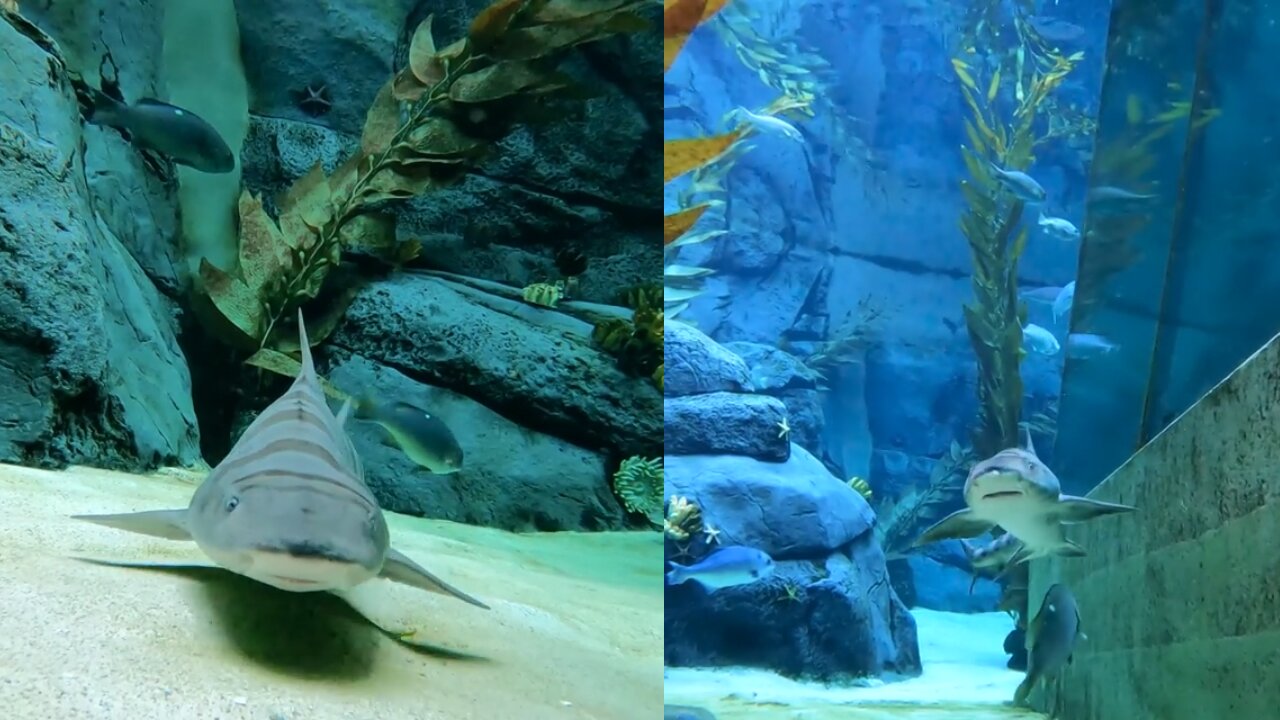Premium Only Content

No sharkasm here leopard sharks and penguins can be tank buddies.
The leopard shark (Triakis semifasciata) is a species of houndshark, in the family Triakidae. It is found along the Pacific coast of North America, from the U.S. state of Oregon to Mazatlán in Mexico. Typically measuring 1.2–1.5 m (3.9–4.9 ft) long, this slender-bodied shark is immediately identifiable by the striking pattern of black saddle-like markings and large spots over its back, from which it derives its common name. Large schools of leopard sharks are a common sight in bays and estuaries, swimming over sandy or muddy flats or rock-strewn areas near kelp beds and reefs. They are most common near the coast, in water less than 4 m (13 ft) deep.
Active-swimming predators, groups of leopard sharks often follow the tide onto intertidal mudflats to forage for food, mainly clams, spoon worms, crabs, shrimp, bony fish, and fish eggs. Most leopard sharks tend to remain within a particular area rather than undertaking long movements elsewhere, which has led to genetic divergence between populations of sharks living in different regions. This species is aplacental viviparous, meaning that the young hatch inside the uterus and are nourished by yolk. From March to June, the female gives birth to as many as 37 young after a gestation period of 10–12 months. It is relatively slow-growing and takes many years to mature.
Harmless to humans, the leopard shark is caught by commercial and recreational fisheries for food and the aquarium trade. This species is mostly fished in the waters off California where, after a period of population decline in the 1980s, new fishing regulations in the early 1990s reduced harvesting to sustainable levels. The International Union for Conservation of Nature has assessed this species as of Least Concern, while noting that local stocks may easily become overfished because of the shark's slow growth and limited migratory habits.
-
 LIVE
LIVE
The Nerd Realm
3 hours ago $6.73 earnedHollow Knight Voidheart Edition #19 | Nerd Realm Playthrough
317 watching -
 1:17:27
1:17:27
Awaken With JP
6 hours agoThe Current Thing: Tesla Protesting - LIES Ep 82
61.7K30 -
 1:07:08
1:07:08
Sean Unpaved
3 hours agoNFL Free Agency Rolls On! MLB Spring Training Heats Up along with 3x World Series Champ Dave Stewart
22.3K3 -
 2:10:15
2:10:15
Right Side Broadcasting Network
8 hours agoLIVE REPLAY: White House Press Secretary Karoline Leavitt Holds Press Briefing - 3/11/25
117K33 -
 2:06:00
2:06:00
The Quartering
6 hours agoTrump Goes NUCLEAR On Canada, Blasts Massie, Harry Potter Race Swap, Man Humiliated On TV Show
69.8K37 -
 1:03:09
1:03:09
The White House
6 hours agoPress Secretary Karoline Leavitt Briefs Members of the Media, Mar. 11, 2025
74.5K52 -
 1:07:03
1:07:03
Winston Marshall
5 hours agoEXCLUSIVE : Oliver Anthony On Life After ‘Rich Men’, The Christian Counter Culture and The Elites
47.2K9 -
 1:44:47
1:44:47
Russell Brand
6 hours agoDigital Censorship & Political Warfare: X Attacked, Rand Paul Rebels, Free Speech on Trial – SF551
140K20 -
 LIVE
LIVE
tastylive
5 hours agoLIVE Stocks, Options & Futures Trading with the Pros! (Market Open -> Close & More) March 11th, 2025
151 watching -
 1:35:59
1:35:59
Simply Bitcoin
6 hours ago $3.57 earnedTrumps Bitcoin Embrace TERRIFIES The EU | EP 1200
51.2K8